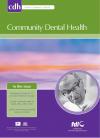Community Dental Health

- Cover Date:
- June 2008
- Print ISSN:
- 0265 539X
- Vol:
- 25
- Issue:
- 2
Correlates of dental caries in 12-year-old children in Europe: a cross-sectional analysis
Objective To investigate, from current cross-sectional data, the relationships between dental caries experience of 12-year-old children in 29 countries of Europe and four independent variables: national wealth (GDP), expressed as purchasing power parity (PPPx1,000US$)/ capita/year; population per active dentist; sugar consumption, expressed as Kg/capita/year; and volume sales of toothpaste, expressed as litres/capita/year. Method Most of the data were abstracted from relevant websites. Information on toothpaste sales was from personal communication and obtainable for 16 countries of Western Europe only. Relationships were examined using Spearman’s rank correlation method. Results Mean DMFT showed a strong negative association with national GDP (rho = -0.729, p < 0.01), whilst toothpaste sales showed a statistically significant positive association with GDP (rho = 0.599, p < 0.05) as did sugar consumption (rho = 0.575, p < 0.01). Paradoxically, caries experience yielded a strong negative correlation with sugar consumption (rho = -0.561, p < 0.01) such that ranked increases in mean DMFT were significantly associated with decreasing levels of sugar consumption. None of the other rank correlations was statistically significant. Conclusions Unavoidable shortcomings of the available data and their incompleteness meant that any conclusions that could be drawn were speculative. A possible explanation for the anomalous association of low mean DMFT with high sugar consumption in Western Europe is that the extensive use of, mainly fluoride containing, toothpaste neutralises the potential damage from high sugar consumption. Use of sugar principally as a commercial food or drink additive in modern times, with potential for buffering of its acidic fermentation products, together with a possibly more rapid oral clearance of sugar in additive form, may also be a contributory factor.
Key words: Correlation, dental caries, national wealth, population per dentist, sugar consumption, toothpaste sales
- Article Price
- £15.00
- Institution Article Price
- £
- Page Start
- 70
- Page End
- 78
- Authors
- M.C. Downer, C.S. Drugan, A.S. Blinkhorn
Articles from this issue
- Title
- Pg. Start
- Pg. End
- Editotial - Do we let children’s teeth decay just because some people object to topping up the natural fluoride that’s already in our water?
- 66
- 69
- Dental caries rates in primary teeth in 2002, and caries surveillance trends 1981-2002, in a South African city.
- 79
- 83
- Individual and maternal determinants of self–reported dental health among Turkish school children aged 10-12 years.
- 84
- 88
- Comparison of ranking dental status using the Significant Caries Index and the Significant Filled and Sound-Teeth Index
- 103
- 106
- Measuring oral health behaviour in Flemish health care workers: an application of the Theory of Planned Behaviour
- 107
- 114
